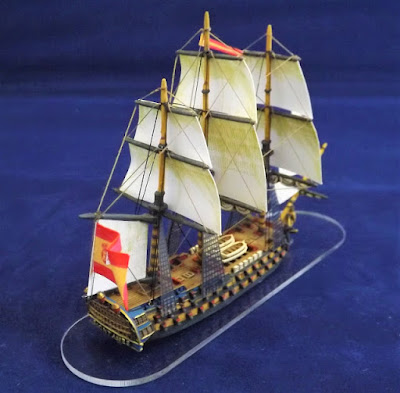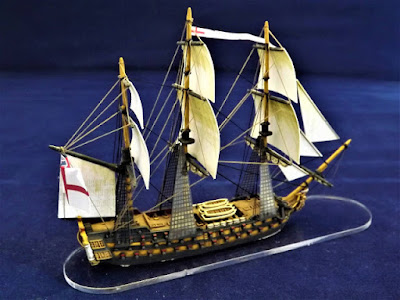The Monarca 74-gun ship of the line begins this series of posts looking at the Spanish third rates of renown.
Another design by the Spanish naval architect, Romero Landa, as part of the four ship Montanes class, and covered in my posts looking at the Montanes and Neptuno.
 |
| Montanes http://jjwargames.blogspot.com/2020/07/all-at-sea-on-stocks-in-jjs-dockyard_15.html |
 |
| Neptuno http://jjwargames.blogspot.com/2020/07/all-at-sea-on-stocks-in-jjs-dockyard_31.html |
Monarca was ordered in 1791 and built and launched at El Ferrol on the 17th March 1794, undergoing proving trials in the autumn of that year alongside her sister ship Montanes under her first commander Captain Don Jose Justo Salcedo y Arauco who took command of the ship in July.
 |
| Captain Don Jose Justo Salcedo y Arauco |
The trial comparison cruises conducted with Montanes between the Azores and Cadiz, escorting Atlantic convoys would see Monarca refitted with new masts and sails before joining Admiral Juan de Langara's squadron in December 1794 in support of the fortified Catalan town of Roses on the Costa Brava then under siege by the French, until it surrendered the following February but not before the garrison of three-hundred men were successfully evacuated by the Spanish navy, with the Peace of Basle ending the war with France signed in July 1795.
 |
| Sunset in Ferrol - Carlos Parilla Penagos https://www.carlosparrillapenagos.es/pintura-naval/ With the castle of San Felipe seen on the right, a Spanish 3rd rate ship enters El Ferol, the port where the similarly rated Monarca was launched and from where she operated from for much of the time from 1798. |
El Ferrol would become the base of operations for Monarca from 1798 to the Peace of Amiens in 1802 coperating with the French squadrons operating out of Rochefort and Brest when able to avoid the British blockade and with the peace, Monarca would end the French Revolutionary War in the port, careened and disarmed, not returning to operations until November 1804 with the declaration of war against Britain on the 14th December.
On the 13th August 1805, Monarca left El Ferrol bound for Cadiz as part of Vice Admiral Pierre Villeneuve's Combined fleet and under the command of Captain Don Teodoro de Argumosa, who had seen action at the Battle of Cape St Vincent in command of the San Isidro 74-guns, where he had exchanged fire with Captains Nelson and Collingwood commanding HMS Captain and Excellent respectively.
The first British ship to engage the Monarca was HMS Mars under Captain George Duff who attempted to pass between her and the stern of the French 74-gun Forgueux, but soon found the gap closed by the French 74-gun Pluton, that had increased sail to pass Monarca and close the gap on Mars not before the British ship fired a close range broadside into the Monarca which bore away under the fire
However as the Tonnant sailed on and no attempt was made to board Monarca and take possession of her, Argumosa raised his colours again, but it seems likely that, with the extensive damage and heavy casualties suffered, the fight had been knocked out of Monarca and she surrendered later in the battle after receiving further hits from HMS Bellrophon which sent across a party of Royal Marines to take control of the ship.
At Trafalgar, the Monarca was armed with 28 x 24-pounder long guns on the lower deck, 30 x 18-pdrs on the upper deck, 12 x 8-pdrs on the quarterdeck and 4 x 8-pdrs on her forecastle.
Thus it was that after a short stay in Cadiz, Monarca sailed with the Combined fleet on the 20th October in spite of enemy frigates seen the previous day as half the fleet struggled to get out of the harbour leaving the other half to exit the next morning in worsening weather, heavy seas, rain squalls and a wind veering to south-south-west, rising to almost gale force as the fleet headed into the Straits of Gibraltar.
Originally part of the van squadron under Vice Admiral Alava in the flagship Santa Anna 112-guns along with Indomptable 80-guns, Forgeux and Pluton 74-guns, the squadron would be the rear as Villeneuve reversed the course of the fleet back to Cadiz as the British bore down on his line of battle ensuring she would be in the centre of the action with Vice Admiral Collingwood's lee column.
 |
| The Battle of Trafalgar 1805, just after noon, showing the approximate position of Monarca in rear squadron. |
 |
| HMS Mars covered in my post from April http://jjwargames.blogspot.com/2020/04/all-at-sea-on-stocks-in-jjs-dockyard_19.html |
The next British ship to come up behind HMS Mars was Captain Charles Tyler's HMS Tonnant which managed to pass the Monarca and pour in her double shotted port broadside before stern raking the Pluton and bow raking the 74-gun Algeciras.
 |
| HMS Tonnant covered in my post from October http://jjwargames.blogspot.com/2020/10/all-at-sea-british-third-rates-of_10.html |
The first broadside from Tonnant was quickly followed by a second and appears to have been a crippling blow, badly damaging her fore and crossjack yards, bringing down her mizzenmast and causing Captain Argumosa to order his crew to cease fire and to haul down his colours earning the dubious honour of being the first Allied ship to surrender at Trafalgar.
 |
| HMS Bellerophon, centre exchanges broadsides with the already battered Monarca to left and the Montanes, to right as the French Aigle hoves into range ahead. |
The Monaraca had suffered one of the highest total fatalities of any ship in the Combined Fleet with 101 killed together with a further 154 wounded, one of only eight ships to have fatalities into three digits, but it was perhaps the extensive damage caused to her hull and rigging that convinced Vice Admiral Collingwood that the ship could not be saved as a prize and she was thus burnt and deliberately wrecked on the 26th October.
She had an over strength crew of 667 men which included 370 naval personnel, 253 infantry (45% of the men onboard) and 54 marine artillery.
Sources consulted for this post:
The Trafalgar Companion - Mark Adkins
The Battle of Trafalgar - Geoffrey Bennett
Next up: I have a review of A History of the Royal Navy in the Napoleonic Wars by Martin Robson, the next Spanish third rate of renown, San Justo and a look at Unhappy King Charles the most recent game Steve M and I have been playing on Vassal.








I love this series JJ, your posts are a great resource for anyone interested in the period.
ReplyDeleteRegards,
Paul.
Hi Paul,
DeleteThank you, glad you are enjoying them. Once the Spanish third rates are reviewed I will be showing the first set of scratch builds completed which include the 80-gun and 64-gun third rates.
Cheers
JJ
Another great work. I´m sorry but wikipedia´s Monarca page is wrong. There was never a series of four Montañes class ships of line. Monarca was an "Ildefonsino" class 74 ship and Montañes was a lone 74 ship, designed by Retamosa as an improvemente of the class. The trials between the two were made in fact to decide the better design for follow up 74 ships, but in the end Montañes was the last 74 spanish ship of line.
ReplyDeleteOn Trafalgar, Monarca´s armament was: 28 x 24, 30 x 18 and 6 x 8 pdr guns; plus 10 x 30, 6 x 24 and 6 x 4 pdr howitzers.
https://www.todoababor.es/datos_docum/arm_nav_traf_vent.htm
Hi Larraspuru,
DeleteThank you and thanks for the update on the class notes and armament.
I must admit to a more superficial knowledge of the Spanish navy and the armament quotes come from Mark Adkins, and I was surprised he made no mention of carronades or howitzers as you describe them, although I have always thought a 4-pounder was a bit light for that kind of close in weapon.
Cheers
JJ
The armament of the spanish ships at Trafalgar is well Known as the official inventory is preserved and published (in spanish). It doesn´t fit with the official ordinances of the time, but those ordinances already included a sizable number of howitzers. No carronades were considered on the ordinances, but that didn´t prevent that some spanish ships had a few of them.
DeleteThe inventory lists several light weapons, but it´s presumed that the 4 pdr howitzers and similar weapons were not used aboard the ship but their main use was to equip the ship´s boats when neccesary.
In the weblink I provided,you´ll see that for Monarca the total guns/howitzers are given as 80 (64 guns + 16 howitzers) instead of 86, because the 6 4-pounders are cited but not counted as main armament.
Greetings.
Another fantastic edition to your fleet! Cheers Greg
ReplyDelete